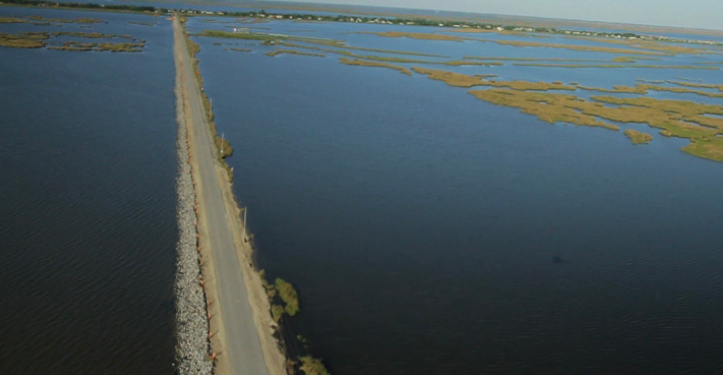
The road to Isle de Jean Charles, Louisiana which has shrunk to 2% of its original size Photo: Inhabit.com
A new plan entitled “Our Land and Water: A Regional Approach to Adaptation” released by the state of Louisiana last month takes a clear-eyed and direct approach to deal with what the state regards as an “existential threat” from climate change as sea level rises and there continues to be major subsidence of land along the coast – in the last 80 years the state has already lost 2000 square miles that have subsided into the Gulf of Mexico. Led by Louisiana’s Strategic Adaptations for Future Environments” (LA SAFE) team, the plan provides “a holistic approach to flood risk of all types as well as the myriad of human, economic, and environmental impacts experienced following past floods and those anticipated in the future.” Specifically, the plan contains strategies for six at-risk Louisiana parishes and recommends a fund of $47 million to launch projects in each location.
- The plan starts from the premise that within 50 years, “Louisiana is projected to lose more land and wetlands along its coast than it can rebuild, even if restoration efforts are completed as currently planned. With less wetland buffer, the state’s coastal regions face increased storm surge and flood risk that will impact families and communities in ways large and small, acute and chronic.”
- And it also recognizes that Louisiana’s coastline is a place of huge economic activity — supplying 90% of the nation’s outer continental oil and gas, handling 20% of the nation’s annual waterborne commerce, and producing 26% (by weight) of the continental U.S. commercial fisheries landings.
Inside Climate News reports that the State’s resilience plan is intended to help local leaders to be prepared to support “planned retreats from areas that are becoming unsustainable.” These impacted communities and the state must be prepared to offer citizens with safe, affordable housing, job training, and other economic opportunities, as well as basic services. In addition, the plan recognizes the importance of addressing the “complex social and cultural needs” of coastal communities and residents who are forced from their homes by rising water, and developing “a sense of place that helps build community.” The Plan builds on the state’s “Master Plan” for restoring wetlands and addressing sea level rise, but recognizes that adaptation and resilience will be needed too because even under the best conditions, there will be impacts that must be addressed.
Why This Matters: Louisiana will not be the only state to need an adaptation and resilience plan, but they will likely need it sooner than most. And this is an impressive effort, funded by the U.S. Department of Housing and Urban Development. We will need lots more funding — whether through a Green New Deal or infrastructure legislation or both — to achieve these ambitious adaptation plans. But at least in Louisiana, they have a plan. Other coastal state leaders should read it and learn. Climate migration is real and it will happen here in the U.S. — in the heart of Trump Country — soon. The President ignored all this reality when he held a “rally” in coastal Louisiana last week to pump up the oil and gas industry.
To Go Deeper: You can read the LA SAFE Plan here — if you want the bottom line, read the Executive Summary and Recommendations — they’re worth your time. To watch the President’s speech on energy infrastructure, click here.
May 20, 2019 » adaptiation, climate change, coastal resilience, sea level rise


